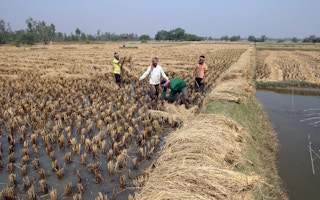Business leaders succeed or fail based on their ability to identify opportunities and risks. Here is how Chad Holliday, Chairman of Bank of America, recently put it: “They [CEOs] get up and they read the Wall Street Journal and the Financial Timesand they watch CNBC … And they’re looking at those things for two reasons. They’re looking for opportunities to maximize or risks to minimize.”
To continue reading, subscribe to Eco‑Business.
There's something for everyone. We offer a range of subscription plans.
- Access our stories and receive our Insights Weekly newsletter with the free EB Member plan.
- Unlock unlimited access to our content and archive with EB Circle.
- Publish your content with EB Premium.
Holliday’s comments were made at the launch of the New Climate Economy report at the United Nations, with UN Secretary-General Ban Ki-moon, former President of Mexico Felipe Calderon, Lord Nicholas Stern, Jeremy Oppenheim and others. Released just one week before the UN Climate Summit, the report delivers a simple, but powerful message: economic growth and climate action can be achieved together. Drawing on new evidence and hundreds of real-world examples, it focuses on opportunities to shift three key economic systems: energy, land use, and cities.
The report finds that we are living in a critical moment, with significant investments that will shape the direction of the global economy and climate for a generation. Over the next 15 years, approximately $90 trillion will be invested worldwide in infrastructure for cities, land use and energy. On top of this, major technological advancements and structural changes in the economy means that a shift to a strong, low-carbon economy is potentially even easier than we previously understood.
Many large businesses are already responding to the shifting trend lines. For example, the CDP reported last week that 29 major companies— including Dow Chemical Company, Bank of America, and ExxonMobil – are already incorporating a carbon price into their business planning and risk management strategies. Just yesterday, Apple CEO Tim Cook announced that his company will take additional measures to reduce their emissions, including powering their data centers from 100 percent renewable energy. Early movers to a low-carbon trajectory will have a significant advantage.
Let’s take a closer look at the three systems and what the findings mean for business leaders:
CITIES: The world’s urban areas are undergoing a radical shift, with 1.4 million people added to cities every week. The most dramatic shifts are taking place in Asia and Africa, where emerging cities are expected to see the most population growth. Cities currently generate 80 percent of global economic output and about 70 percent of global energy use and energy-related greenhouse gas emissions. But, many cities grow in unplanned, unstructured ways that are financially and environmentally inefficient and less able to attract the most talented employees.
Cities that are compact and well-connected can be more economically dynamic and more livable for residents. The New Climate Economy report finds that the United States could save $200 billion a year by pursuing more compact urban growth policies, primarily due to cost savings in providing public services and capital investments. Investment in sustainable infrastructure and transport systems, including bus rapid transit, rail, energy efficient buildings and other innovations, are opening new opportunities for companies and investors alike.
“
We can improve the economy and tackle climate change at the same time. As Lord Nicholas Stern said at the New Climate Economy launch, “If we choose low-carbon investment, we can generate strong, high-quality growth – not just in the future, but now.”
LAND USE: Increasing the productivity of land will largely determine whether the world can feed a population of 8 billion people by 2030, while sustaining natural resources for the future. Solutions are emerging that will increase productive land and open new investment possibilities. For example, restoring just 12 percent of the world’s degraded farm land could feed 200 million people by 2030 and raise farmers’ incomes by $40 billion a year. At the same time, it would reduce greenhouse gas emissions and strengthen communities’ resilience to climate impacts like droughts, floods, and extreme weather events.
Many businesses are also adopting more sustainable forest management practices. Major commodities, like soy, palm and beef, are the main drivers of deforestation globally—which harms livelihoods and biodiversity. WRI recently launched a new online platform, Global Forest Watch Commodities that is creating greater transparency and enabling businesses to better monitor their supply chains. Unilever is among a group of leading companies that have embraced this new platform to improve efficiency and reduce its environmental impact.
ENERGY: With the rapid decline in the cost, renewable energy is quickly becoming the smart choice for new electricity generation. Over the past five years, the cost of wind energy has decreased 58 percent, according to the financial services company Lazard. The cost of solar technology has likewise been cut in half since 2010, according to the Renewables Global Status Report. With the right policy signals, more than half of all new electricity generation could come from renewable energy within the next 15 years.
Investing in energy efficiency—in businesses, buildings and transport—can help both reduce electricity costs and lessen demand. Energy demand has already declined by 40 percent in developed countries over the last four decades. As Chad Holliday said, “I would be shocked if energy efficiency doesn’t have a greater impact on the world than shale gas does in the next five years.”
All these numbers add up to a myth-busting conclusion: we can improve the economy and tackle climate change at the same time.As Lord Nicholas Stern said at the New Climate Economy launch, “If we choose low-carbon investment, we can generate strong, high-quality growth – not just in the future, but now.”
Manish Bapna is the executive vice president and managing director of the World Resources Institute (WRI). This post is republished from the World Resources Institute’s Insights blog.











